History of cycling in Syracuse, New York
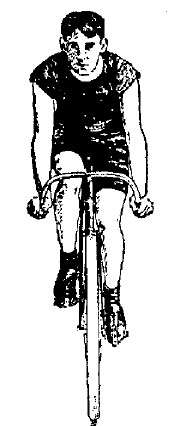
Cycling in Syracuse, New York, has been common on the roads and paths for recreation, commuting, and as a sport since the latter part of the 19th century.
During the 1890s bicycling was a new mode of transportation and a popular sport, however, overall bicycle usage declined with the advent of the automobile in the early 20th century. By mid-century, the bicycle was considered a child's toy. Since the 1970s, use of the bicycle for health, fitness and as a non-polluting alternative to the automobile has grown in Syracuse as well as across the United States.
By 1895, Syracuse was the "hub" of the bicycle world, at one time, manufacturing as many as 500 machines in a single day. The most popular and wealthiest bicycle manufacturer in the city was E. C. Stearns Company, producer of the popular Yellow Fellow for nearly a decade.[1]
Context
The bicycle followed the roller-skate in the 1890s as a new mode of transportation. High-wheeler bicycles preceded the "safety bike," however, it was the new, fast "low bikes" that brought about the cycling "craze."[2] The number of bicycle riders in Syracuse during the decade totaled 10,000 and the city was a "hub of bicycle production." Among the most popular bicycles were the Yellow Fellow manufactured by E. C. Stearns Company who employed 2,000 and made 500 bicycles a day. Bicycles were so popular during that period that streetcar earnings declined.[3]
The total number of cyclists in the United States at the close of 1906 was conservatively estimated at 1.5 million and manufacturers throughout the country built 2.25 million bicycles that year.[4]
Cycling as a sport
As early as 1888, bicycling was a popular sport with affluent young men of the city. Some of the early names in racing were John Wilkinson and William Van Wagoner. Professional and amateur racers, using "local" wheels, toured the United States, Europe and Australia to compete in various competitions.[1]
During the 1890s cycle races like the Cicero Plank Road Race in Cicero, New York and the Century run of the Century Road Club to Utica and back were very popular forms of entertainment and drew thousands of spectators.[5]
Many cyclists tried for the "century" mark, making 100 miles (160 km) runs.[6]
Bicycle racers
Some of the early names in racing were John Wilkinson (1868–1951) who was a native of Syracuse and graduate of Cornell University with a degree in engineering.[6] Always athletic, by 1880, Wilkinson participated in bicycle racing and was one of the country's leading racers.[7] After college he went on to become a champion cyclist and also developed a keen interest about the inner-workings of internal combustion engines and motor cars. He later invented the air-cooled engine and teamed with Herbert H. Franklin to form Franklin Automobile Company.[6]
William Van Wagoner, originally from New Jersey, was manager of Century Motor Vehicle Company by 1900 and an early automobile designer, however, he was involved in bicycle racing long before he designed an automobile. During June 1888, Van Wagoner was a "bicycling champion" in Providence, Rhode Island in the third annual 25 miles (40 km) bicycle race for the championship of the Rhode Island division on the .5 miles (0.80 km) oval at Roger William's Park.[8] He performed in many events around the country and by July 1893, he had settled in Syracuse and was racing with the Syracuse Athletic Association.
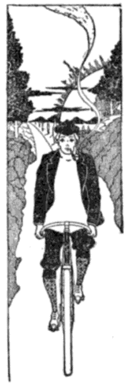
Many professional riders such as Eddie Bald, riding the Cannon Ball carried the name of Syracuse-made machines into the national cycling field.[2]
Cycling clubs

The League of American Wheelmen was founded in Newport, Rhode Island on May 30, 1880 by Kirk Munroe and Charles Pratt. It soon became the leading national membership organization for cyclists in the United States.[9] The League was also the governing body for amateur bicycle racing in the U.S. during the late 19th century. Membership peaked at 103,000 in 1898.[10]
The Syracuse Athletic Association, formed in 1889 with headquarters in the Lynch block between Salina and Water streets,[1] was an important young men’s club in the city and promoted sports activities including cycling events. By 1893, the eighth annual Labor Day meet was hosted by the group on September 4. Two special features would prove very interesting. William Van Wagoner, a member of the club, rode 1 mile (1.6 km) against time with hands off in an effort to lower the world's record of 2:38. "He succeeded admirably," making the 1 mile (1.6 km) in 2:29. He rode with his arms folded behind him and his wheel was as "straight and accurate as many good men ride with hands on." The performance took place on the .5 miles (0.80 km) track at the New York State Fair grounds which "was in excellent shape" and was loudly applauded by a crowd of 5,000.[11]
The Syracuse Bicycle Club (SBC) was formed in the early 1890s followed by the Century Bicycle Club and Pastime Club. Both the Syracuse Athletic Association and the Syracuse Bicycle Club were merged through the efforts of Frederick B. Hazard[1] and moved to the old Getman Hotel on East Jefferson Street. The building burned down in 1896 and they built a new clubhouse on the corner of State and Washington streets.[12]
Bike paths
In 1897, special paths were first constructed in the city and every "wheel" rider had to carry a tag showing payment of a tax to maintain the paths. There were "special constables" to arrest those unlawfully cycling on the paths. There were also laws for special protection of wheel paths, as well as laws against bicycle riders.[13]
The bicycle paths branched out from the city to the old Onondaga Lake Boulevard, to Cicero and South Bay, along the old Plank Road, the first in the United States to Onondaga Valley and Elmwood.[2]
Bicycle gears
Local entrepreneurs and engineers, Alexander T. Brown and Charles E. Lipe invented the two-gear chain in 1894 in order to offer different speeds to the more advanced riders. The gears were produced at the Brown-Lipe Company who called it their two-speed Hy-Lo Bi-Gear which was installed on all makes of bicycles.[12]
The company was located in Syracuse, in the C. E. Lipe Machine Shop, an early business incubator in the city.[14] The firm was renamed to the Brown-Lipe-Chapin Company who were later recognized as the world's "premier automobile gear manufacturer."[12]
Bicycle designers and manufacturing
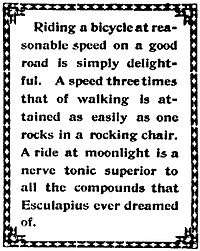
The cycling craze was first imported to the United States from England in the early 1880s. English bicycles such as Beaston-Humber and the Rugby sold for as much as $165, weighed 26 pounds, and required tires that cost $25 apiece. As popularity grew, American manufacturers entered the field.[1]
Many young men in the city began their careers in the bicycle industry which was a new, exciting technology of the time. Several such as Wilkinson and Van Wagoner began racing bicycles by 1888 and gravitated to design and manufacturer of bicycles by the mid-1890s. Several were instrumental not only in the establishment of Syracuse as a major bicycle manufacturing center, but later they moved on to form several automobile manufactories in the city.
At one point more than 300 firms across the United States were trying to corner the bicycle market. Syracuse became a center of "safety" bicycle manufacturing.[2] Bicycles that were not produced locally were referred to as "out of town" machines. Not only did the manufacturers produce bicycles and tricycles, but they also turned out the "bicycle built for two" as well as some models designed to carry three, four, five, six and even seven riders.[1]
In the 1890s, some of the popular models of the day were Fowler,[15] Stearns and Rambler which were sold nationwide at authorized "dealers."[16] "Local" bicycles included the Barnes White Flyer, Empire, Tourist and Dodge.[1]
Syracuse had no fewer than 19 local bicycle manufacturers including Barnes Cycle Company (1895–1899), Central City Bicycle Works (1898), Dodge Cycle Company (1896), E. C. Stearns Bicycle Agency (1893–1899), Emory, Empire Cycle Company (1896–1898), Frazier & Jones Company (1898), Frontenace Manufacturing Company (1896), H. R. Olmsted & Company (1896–1898), J. C. Brown & Company (1904), J. W. Gould (1898), Lighton Machine Company (1895–1896), Olive Wheel Company (1897–1901), Ruben Woods, Syracuse Cycle Company (1894–1898), Syracuse Specialty Manufacturing Company (1896), makers of the Frontenac, Tourist Bicycle Company (1896–1898), Wooden Hickory Frame Cycle Works (1893–1898) and[17] Worden Frame Hickory Bicycle Works.[16]
Along with the bicycle manufacturers, came a host of other industries such as bicycle maintenance shops and gear manufacturers and tire repairers. Some shops, such as Howlett's Rubber Store of 212 South Clinton Street, offered storage services where you could park your bicycle for the winter months through April 1 for one dollar. All combined, the bicycle industry helped to create many jobs to boost the local economy.[18]
In the period from 1890 to 1896, when the "peak of the bicycle fad" was reached, average prices for new bicycles ranged from $65 to $200.[19]
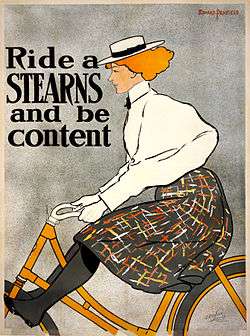
E. C. Stearns & Company
E. C. Stearns & Company began business as a hardware manufacturer and branched into bicycle production from 1893 through 1899[17] after Edward C. Stearns brought the industry to Syracuse in 1888 and transformed his father's hardware and wagon factory in Oneida, New York to a bicycle plant.[1]
Stearns, president and founder of E. C. Stearns Bicycle Agency, established several other manufacturing plants in Syracuse including E. C. Stearns & Company (hardware), Wholesale Bi-steam Carriage Company and Stearns Automobile Company or Stearns Steam Carriage Company.[20]
The company manufactured the popular model, Yellow Fellow by 1895.[21] The "bike" was produced by the thousands at the Syracuse plant and "made the name of the city familiar in almost every corner of the world." The slogan read The Yellow Fellow from Syracuse.[19]
The company produced the model for nearly a decade during which time the "Stearns people ruled the bicycle world."[1]
Barnes Cycle Company
Barnes Cycle Company was another bicycle manufacturer in Syracuse. They were located on East Water Street and were most known for their White Flyer. William Van Wagoner, popular Syracuse bicycle racer, designed bicycles for the company and by 1895 was known as a tandem builder. According to the daily newspaper on June 23, 1895; "Von Wagoner was born in advance of his age. It is highly probable that the fertile brain of Van Wagoner, who designed so many new model bicycles, will create a good many improvements to show the public when next year's model is put upon the market." At that time, he was building a machine for his own personal use that was considered "a novelty in bicycle construction."[22]
According to a local news reporter, the 1896 model of the Barnes bicycle was "an aggregation of more good qualities than ever put together in a bicycle before." An innovative joint had been an "important feature" the previous year and had been "further improved and strengthened" by 1895.[21] The 1896 model was in high demand and agents that filed applications for the White Flyer were so numerous, the company had to assign them each a number and they had to "respond to the call of next as they would in a barber shop."[21]
The company catalog was considered a work of art in 1896 "that will be prized as a souvenir and preserved for its artistic excellence." The cover was printed in the Barnes colors; purple, white and gold and "bears a large winged wheel in white, the symbol of the White Flyer." Barnes announced five models that year.[23]
 Barnes Bicycle Advertisement in April 1896 |
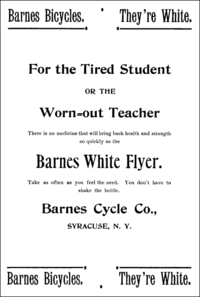 Barnes Bicycle Advertisement - Education magazine, September 1896 |
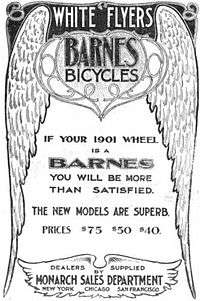 Barnes Bicycle - Advertisement, Good Roads, June 1900 |
Olive Wheel Company
F. W. Gridley was president of the Olive Wheel Company in 1897. The company had recently opened a new store at 121 West Jefferson Street. The color scheme of both the interior and exterior were a "rich olive" hue. The interior was "handsomely frescoed with olive set off with a pretty tint of robin's egg blue and the floors were carpeted with heavy rugs of a rich olive hue." On a platform extending from one end of the store to the other were displayed a full line of Olive wheels in all models including The Olivette, the Enterprise and the Olive Wheel. The Olive Wheel tandem occupied a place of honor on the pedestal. The Frazier & Jones line of juvenile bicycles were also carried in stock. The store was under the "capable management" of Edward P. Wilkins "who is possessed of more than ordinary business ability" and was an "enthusiastic" cyclist and was well versed on all that pertained to bicycles.[24]
Syracuse Cycle Company
In November 1895, John Chester Bowe was the president and general manager of the Syracuse Cycle Company.[21] In April 1896, the company advertised they had been in business since 1892 and were makers of the Syracuse Bicycle with the famous Crimson wheel also known as the Crimson rim. The company motto was "There is but one crimson rim--it is the Syracuse."[25]
During the mid-1890s, John Wilkinson went to work for the Syracuse Cycle Company on Wyoming Street as a designer where he stayed for about four years.[26] In 1895 he designed and patented the "Syracuse quadruplet," the fastest cycle in the world, establishing a record of 1:45 for a three lap track.[7] Wilkinson also designed the company's famous Crimson Rim.[1]
On January 20, 1895, the company participated in the New York Cycle Show which was held in Madison Square Gardens in New York City where they displayed models of the year including the Racer, Special, Spacer, Model C and Thelma, a ladies model. They also showed off their tandem, which weighed 36 pounds (16 kg). The New York Times reported that "these machines are prepared in a very handsome manner, and are sure to find many admirers."[27]
 Syracuse Cycle Company - Advertisement - The Daily Standard, April 21, 1896 [28] |
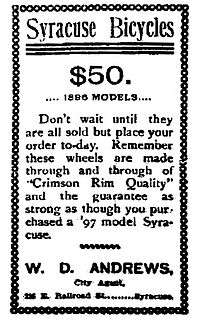 Syracuse Cycle - Advertisement, The Syracuse Daily Standard, May 15, 1897 |
Westfield Manufacturing
Westfield Manufacturing Company of Syracuse manufactured pneumatic safety bicycles with "tall cushion" frames in 1898.[29]
Worden Bicycles
In July, 1897, Worden Hickory Frame Cycle Works maker of Worden Bicycles, sold their bicycles from the Olive Wheel Store at 121 West Jefferson Street.[16]
Market saturation
By 1896, the bicycle industry reached a "bitterly" competitive crisis. The market was clearly flooded by too many manufacturers.[1]
Prices for the top name brands were expensive. The price for a standard model was $100. As the market heated up, large manufacturers began offering models under "other names" for $75. They were soon undercut by department stores that had models for as low as $50. One could also purchase a bicycle at a so-called "auction" store for $40; however, the less expensive bicycles broke down quickly.[1]
On March 1, 1897, the industry peaked in Syracuse with the annual bicycle show at the Alhambra hall when hundreds of different makes and models were on display and Tom Eck posted advertisements for his famed cyclist school at the State Fair Grounds.
Within three years time, in 1900, the blow fell. In an attempt to control supply and limit competition, 42 manufacturers (later over 75 companies) formed the American Bicycle Company (A.B.C.), known familiarly as "the trust." The concern bought up one company after another and eventually had formed into a monopoly. Even strong, profitable companies such as E. C. Stearns Bicycle Agency sold out their rights to the new conglomerate. In a few years, the center of bicycle manufacturing shifted to Westfield, Massachusetts and Hartford, Connecticut and Syracuse manufacturers were forced to produce other products.[1]
A.B.C. soon announced plans to open a branch plant in Canada called the National Cycle Company[30] located in Hamilton, Ontario. Some of the other companies that merged in 1900 were E. C. Stearns Company of Toronto, Ontario, Evans & Dodge Bicycle Company and The Dodge Brothers.[31]
Wholesale and retail dealers
The W. A. Doubleday Company, wholesale and retail dealers in bicycles and sundries, purchased the Frontenac Bicycle Company in January 1901. George M. Barnes and Austin M. Dickinson were affiliated with the company and decided at the end of 1900 to retire from the bicycle trade and the business was offered for sale. The hardware department of the company works was sold to Phoenix parties and the factory was extensively remodeled for the Stearns Steam Carriage Company. There was a Frontenac wheel produced in 1901 under the control of the Doubleday company.[32]
Bicycle accessories
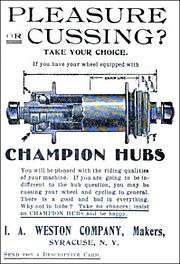
Several companies in the Syracuse area produced various parts for the bicycle industry. In June 1900, the I. A. Weston Company was a producer of Champion Hubs for the wheel.[33]
Syracuse racers
Most raced for local bicycle manufacturers nationally and even worldwide. A few were native Syracusans;
- E. E. Anderson () - Professional racer from St. Louis, Missouri, of "mile a minute fame," rode a Stearns bicycle during the 1897 season.[34]
- Eddie Bald (1874–1946) - Professional racer rode the Cannon Ball and carried the name of Syracuse-made machines into the national cycling field.[2]
- Carroll B. Jack () - Raced for Stearns in 1896.[34]
- John S. Johnson (1873–1934) - Rode a Stearns wheel when he made a "remarkable mile" in 1:35 in 1895.[35]
- Earl Kiser (1875–1936) - Member of team of Round-the-World Yellow Fellows in 1896. He was nicknamed the "Little Dayton Demon".[36]
- William Martin () - Member of team of Round-the-World Yellow Fellows in 1896.[37]
- John J. McLaughlin () - Raced on a Stearns Yellow Fellow and broke the record on December 18, 1894.[38]
- C. M. Murphy () - Professional bicyclist and winner of the Madison Square Garden races. Later hired by E. C. Stearns & Company in 1896 to ride the Stearns bicycle in Paris, France.[19]
- Marshall Taylor (1878–1932) - Raced for E. C. Stearns Bicycle Agency in 1899.[39]
- William Van Wagoner (1870-) - Competitive bicycle racer in the Northeast from 1888 to mid-1890s. Went on to design Barnes bicycles and later automobiles.[8]
- Harry Wheeler () - Member of team of Round-the-World Yellow Fellows in 1896.[19]
- John Wilkinson (1868–1951) - By 1880, he was one of the country's leading bicycle racers and later worked for Syracuse Cycle Company where he designed the Crimson Rim. By his mid 20s he went on to design the Franklin automobile air-cooled engine.[6]
See also
References
- 1 2 3 4 5 6 7 8 9 10 11 12 13 LaRue, Arlene (February 13, 1983). "When Syracuse was hub of the bicycle world". Syracuse Herald-American. Syracuse, New York.
- 1 2 3 4 5 Early, Frank J. (January 31, 1940). "Bicycle and Automobile Set New Tempo and Brought More Industry to Syracuse". The Post-Standard. Syracuse, New York.
- ↑ "Syracuse Scenes 1880-1900". The Post-Standard. Syracuse, New York. July 29, 1998.
- ↑ "Bicycle Riders Form a Mighty Phalanx". The Post-Standard. Syracuse, New York. January 26, 1907.
- ↑ "Van Wagoner Holds the Record". The Evening Herald. Syracuse, New York. October 27, 1893.
- 1 2 3 4 "He Smashed the Record". Evening Herald. Syracuse, New York. July 20, 1893.
- 1 2 Doman, Carl. "The Two Johns (1954)". The H. H. Franklin Club, Inc., Syracuse, N.Y., November 17, 1998.
- 1 2 "Cycling Champions at Providence". Boston Daily Globe. Boston, Massachusetts. June 28, 1888.
- ↑ Oliver, Smith Hempstone; Berkebile, Donald H. (1974). "Wheels and Wheeling: The Smithsonian Cycle Collection". Smithsonian Institution Press. Retrieved 2009-07-17.
- ↑ Stanford Braff, Carolyn (Nov–December 2007). "The Perfect Time to Ride: A History of the League of American Wheelmen" (PDF). American Bicyclist: 18–23. ISSN 0747-0371. Check date values in:
|date=(help) - ↑ "Murray, Gardner, Hughes". The Syracuse Courier. Syracuse, New York. September 5, 1893.
- 1 2 3 "Syracuse ruled the bike world in 1890s". Syracuse Herald. Syracuse, New York. 1920.
- ↑ "Bicyling Craze Made City Hub of Bicycle World". The Post-Standard. Syracuse, New York. September 13, 1953.
- ↑ Motor age, Volume 5, No. 23. The Trade Press Co., Chicago, Illinois - January, 1904. Retrieved January 2, 2011.
- ↑ "The Fowler". Syracuse Daily Standard. Syracuse, New York. April 21, 1896.
- 1 2 3 "Worden Bicycles". Syracuse Daily Standard. Syracuse, New York. July 3, 1897.
- 1 2 "Bicycle Brands Home Page". The Wheelmen, 2010. Retrieved January 7, 2011.
- ↑ "Howlett's Rubber Store". The Post-Standard. Syracuse, New York. January 9, 1904.
- 1 2 3 4 "Cycle Trade Association Reports Sport Growing With Many Communities Forming Riding Clubs". Syracuse Herald. Syracuse, New York. September 14, 1930.
- ↑ Notable Men of Central New York. Dwight J. Stoddard, 1903. Retrieved 2010-08-14.
- 1 2 3 4 "Bicycle Trade - News from the Headquarters of Makers and Dealers". Syracuse Standard. Syracuse, New York. November 17, 1895.
- ↑ "The Bicycle Trade". Syracuse Standard. Syracuse, New York. June 23, 1895.
- ↑ Recreation, Volume 4. G. O. Shields, New York City - June, 1896. Retrieved September 31, 2010. Check date values in:
|access-date=(help) - ↑ "Bicycle Trade - Stearns and Barnes". Syracuse Standard. Syracuse, New York February 28, 1897.
- ↑ "Syracuse Bicycles". The Daily Standard. Syracuse, New York. April 21, 1896.
- ↑ Fitch, Charles Elliott. Encyclopedia of biography of New York. The American Historical Society, New York, N.Y., 1916, pg. 123.
- ↑ "New York's Cycle Show". The New York Times, New York, New York, January 20, 1895. January 20, 1895.
- ↑ "Syracuse Cycle Company - Advertisement". The Daily Standard. Syracuse, New York. April 21, 1896.
- ↑ "Bicycle; Westfield Mfg". Internet Antique Mall, 2010. Retrieved December 31, 2010.
- ↑ http://www.sciencetech.technomuses.ca/english/collection/cycles15.cfm
- ↑ Watson, Bill. Chronological History of Chrysler Corporation. Allpar, 2010.
- ↑ "Stearns Steam Carriage". The Post-Standard. Syracuse, New York. February 3, 1901.
- ↑ Good roads: devoted to the construction and maintenance of roads, Volume 31. Emil Grossman & Bros., New York, New York, June 1900.
- 1 2 "Notes of the Trade". The Evening Herald. Syracuse, New York. May 31, 1897.
- ↑ "John S. Johnson - Amateur". Syracuse Herald. Syracuse, New York. August 5, 1894.
- ↑ "Archdeacon: Cemetery brings sporting past to life". Cox Ohio Publishing, 2010.
- ↑ "William Martin Stearns Bicycles". The New York Times. New York, New York. April 15, 1896.
- ↑ "Among the Wheelmen". The New York Times, New York, New York. March 17, 1895.
- ↑ Ritchie, Andrew (1988). Major Taylor: The Extraordinary Career of a Champion Bicycle Racer. The Johns Hopkins University Press. pp. 114, 131. Retrieved January 12, 2011.
External links
- 1895 Stearns
- 1896 Stearns "Yellow Fellow"
- White flyer advertisement, Los Angeles Herald, April 1, 1900